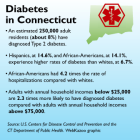Disparities
Deep Roots Drive Newhallville Stakeholders To Advance Neighborhood Equality
|
At the corner of Shelton Avenue and Hazel Street in Newhallville sits a green space, the Learning Corridor—a hub for educating young children and connecting families to healthy living. The Farmington Canal Heritage Trail runs through the garden, where children can stop by and browse books from a box and adults can take a spin on a bike. Once known in the neighborhood as the “mud hole,” a crime spot for “drug trafficking and all kinds of stuff,” the Learning Corridor is now a place where neighborhood residents gather to take care of their health and well-being, said Doreen Abubakar, founder and volunteer director of the Community Placemaking and Engagement Network (CPEN). “We held a six-month in-house training about diabetes,” Abubakar said. “My sister who had diabetes brought down her blood sugar to pre-diabetic levels after she did the training.” The participants learned the importance of exercise to manage their diabetes, and residents joined the national walking club movement Girl Trek.



